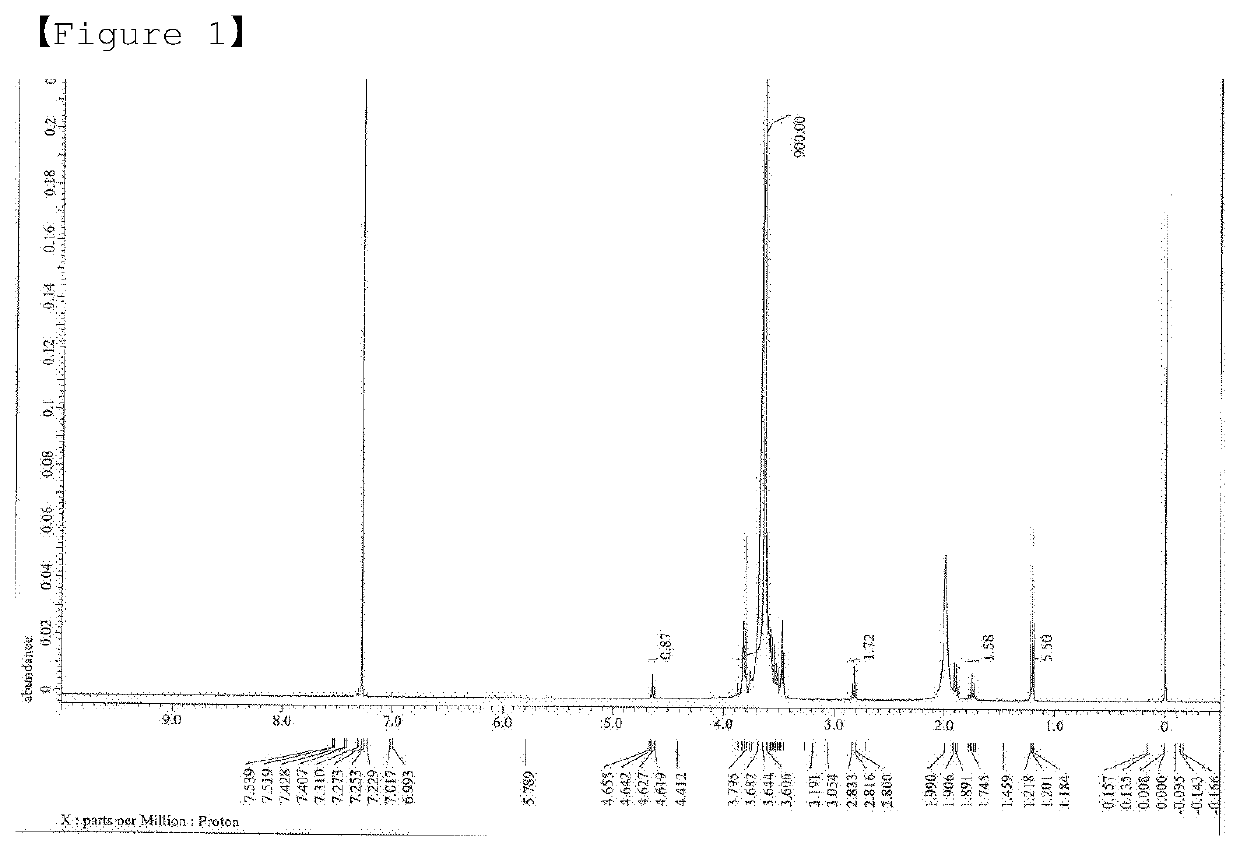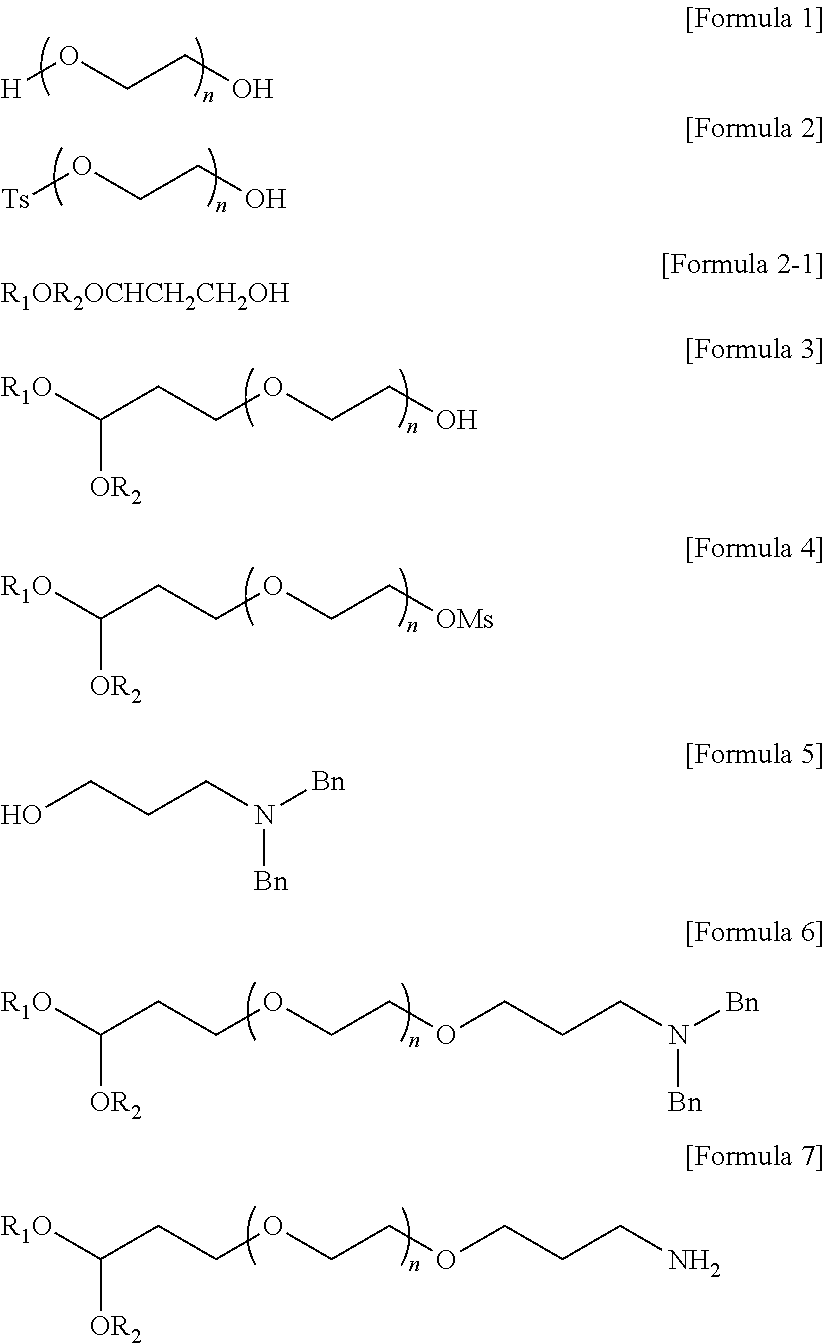Polyethylene Glycol Derivative And Preparation Method Thereof
a technology of polyethylene glycol and derivatives, applied in the preparation of sulfonic acid esters, organic chemistry, chemistry apparatus and processes, etc., can solve the problems of reducing the adaptability of medication, and achieve the effect of reproducible mass production of high-quality products, appropriate and effective mass production, and high adaptability
- Summary
- Abstract
- Description
- Claims
- Application Information
AI Technical Summary
Benefits of technology
Problems solved by technology
Method used
Image
Examples
example 2
on of Compound 3
[0107]400 of toluene and 10.2 g of diethoxy-1-propanol were added to the reaction vessel. After adding 3.9 g of potassium t-butoxide, the temperature was raised to 50° C. and stirred at 50° C. for 1 hour to prepare an activation solution. 100 g of compound 2 and 400 of toluene were added to another reaction vessel, and then heated to 40° C. to dissolve compound 2. The mixture was added dropwise at 40° C. for 20 minutes to the activation solution cooled to 40° C. After stirring at 40° C. for 3 hours, extraction was performed by adding water to the reaction solution. After separation of the layers, dichloromethane was added to the aqueous layer and stirred for 5 minutes. The organic layer was separated, dried over magnesium sulfate, and filtered, and the remaining filtrate was concentrated under reduced pressure. 100 of dichloromethane was added to the concentrate to dissolve it, and then 1.5 L of methyl t-butyl ether was added dropwise for 20 minutes. The resulting...
example 3
on of compound 4
[0109]40 g of compound 3 and 120 a of dichloromethane were added to the reaction vessel. 3 of triethylamine and 1.5 of methanesulfonyl chloride were added while maintaining the reaction temperature at 10° C. or less. Stirring was performed at room temperature for 3 hours. After completion of the reaction, water and dichloromethane were added and stirred for 5 minutes. After extracting the organic layer, dichloromethane was added again to the water layer and extracted further. The organic layers were combined, dried over magnesium sulfate, and filtered and the remaining filtrate was concentrated under reduced pressure. 40 of dichloromethane was added to the concentrate to dissolve it, and 600 of methyl t-butyl ether was added dropwise for 20 minutes. The resulting crystals were filtered, washed with methyl t-butyl ether and dried at room temperature under nitrogen to obtain 38 g (yield: 95%) of the target compound 4.
[0110]1H-NMR (CDCl3, 400 MHz) δ 4.65 (t, 1H, J=...
example 4
on of Compound 6
[0111]160 of toluene and 10 g of compound 5 were added to the reaction vessel. 11 of potassium t-pentoxide (25 wt. % of toluene solution) was added thereto, the temperature was raised to 50° C., and the solution was stirred at 50° C. for 1 hour (activation solution). 40 g of compound 4 and 400 of toluene were added to another reaction vessel, and then heated to 30° C. to dissolve compound 4. The activation solution cooled to 30° C. was added dropwise to the mixture at 30° C. for 1 hour. After stirring for 3 hours at 30° C., extraction was performed by adding water to the reaction solution. After separation of the layers, dichloromethane was added to the aqueous layer and stirred for 5 minutes. The organic layer was separated, dried over magnesium sulfate, and filtered, and the remaining filtrate was concentrated under reduced pressure. 40 of dichloromethane was added to the concentrate to dissolve it, and 600 of methyl t-butyl ether was added dropwise for 20 min...
PUM
| Property | Measurement | Unit |
|---|---|---|
| temperature | aaaaa | aaaaa |
| reaction time | aaaaa | aaaaa |
| temperature | aaaaa | aaaaa |
Abstract
Description
Claims
Application Information
 Login to View More
Login to View More - R&D Engineer
- R&D Manager
- IP Professional
- Industry Leading Data Capabilities
- Powerful AI technology
- Patent DNA Extraction
Browse by: Latest US Patents, China's latest patents, Technical Efficacy Thesaurus, Application Domain, Technology Topic, Popular Technical Reports.
© 2024 PatSnap. All rights reserved.Legal|Privacy policy|Modern Slavery Act Transparency Statement|Sitemap|About US| Contact US: help@patsnap.com










